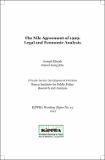| dc.description.abstract | The Nile Agreement of 1929 established two substantive rules. First,
it granted Egypt the exclusive property rights over the waters of the
River Nile based on prior use. According to Coasian analysis, such a
framework would have been efficient because, historically, it would
have been difficult to define water rights in the Nile Basin, where most
riparian countries were not sovereign and not clearly demarcated.
Also, relative to other riparian countries, Egypt had invested more
on irrigation than its counterparts. Second, the property rule was
enshrined in the Agreement to legally protect Egypt’s established
property rights. In retrospect, use of property rule, coupled by the fact
that the Agreement did not impose Egypt with any obligation towards
other riparian countries, renders the Agreement inefficient because
it empowered Egypt to monopolize the utilization of the Nile waters. | en |

